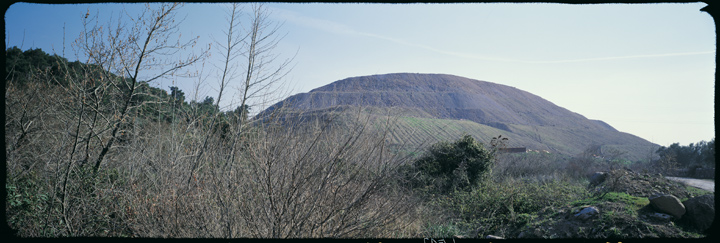
 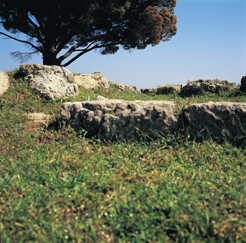  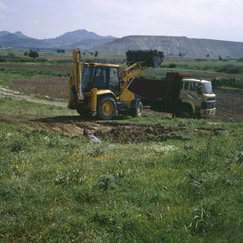  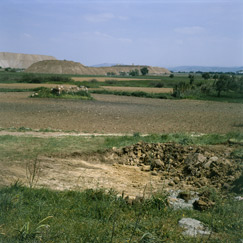  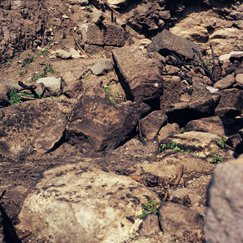 |
TR // ENG
VOID: A View from Acropolis
Postulations 1. Remains of cataclysmic events are archaeological objects that can be meaningfully studied through artistic methods. [We are referring to artistic method as the phenomenological approaches of articulating, approaching, observing, studying, documenting the social phenomenon vis-a-vis its spatial context. Further critical actions should be taken with respect to the findings. Any techniques and tools should be relevant to the method.] 2. Anatolian territory is covered with thousands of species of plants, a good part being endemic. The sedimentation of soil, the flora-covers the mythic landscape of civilizations. This landscape acts as a protective layer for the archaeological ruins, i.e. the top layer of the historical stratification acts as a blanket; quietly warming, taking care of, and filling the voids by time. It presents a variety of flowers as decoration. 3. Structures can be understood through their voids. Void, in our case, is the spatial realm, which is in between the archaeological formation and the contextual framework that the site rests on (for instance, structural cracks in the buildings). The non-content created can be understood through remains of everyday life at the time of the catastrophe. 4. Science fails to show the complexity of the social phenomena within its authoritarian discourses. Categorical reductions eliminate the understanding of social voids. The social ought to be understood through its void. The contextual environment of the objects defines the possibility of the void. Nothing is transcendent about it. 5. First, the void can be understood as a meaningless ground of circulation. Second, physical forms are necessary. However, the point of departure is not to be a monumental structure but the voids themselves, i.e., instead of reading the registered aspect (read monumental), the approach attempts to grasp the immersed as it is in utterances (read filling in the void). 6. If Middle East (to include the Anatolian Plateau) as the sedimentation of a tormented history is still relevant, it is because it antedates the 'Classical-as-the-origin'. Not only does archaeology as we understand dispense with the task of restoring the original, but also we know that the blind poet of the Iliad dreamed of his ur-history, the time when all that was solid melt into the soil. We believe that the prehistoric (i.e. Neolithic) wisdom still punctuates the conflicting frames of acceptance of the world and fate, as we observe through the modern catastrophe: ruins, cruelties, torture and unspeakable atrocities that infest the region. The anti-monumental, anti-hierarchical organization of the pre-classical site still humbles the spirit of the people, as it leaves no trace of itself in disappearing, as it melts into the soil that it was made of, like all mortals, just but a sign, a tumulus, a grave covered with flowers. The Procedure Keywords: Dig, Excavation, Earth, Dirt, Evidence, Site, Location, Transfer, Truck, Gallery, Mine, Farm, Grain, Defense, Subtraction, Antagonism, Twofold, Unfold 1. What is a dig for us?
Transference: The excavation took place in Sağancı, a village neighboring the gold mine to the west. Our contacts were villagers, the local government, activists and others passionately involved in the struggle against the mine and for the return of the Altar back to Bergama. 2. Why do we choose that specific location? * Colonialism: Extracting and exploiting the ‘local’ resources and transferring ‘the extracted’ overseas. 3. The connection between sites: Bergama –> Istanbul –> Berlin For us the process of transferring is more essential than the actual result/form created during the process for which failures are also the part. Being well aware of the polemics and histories of the two controversies (gold mining with cyanide and all there is in the Pergamon Museum in Berlin), we tend to take a tangential approach to sensitize a chosen site/situation in order to make possible other vistas. Istanbul is merely the stop in the way which, in the past, facilitated the transactions among the nodes of power that actualized the exploitation in both cases, and now, for us, the given site of the non-museum for our non-memorial. If archaeology is the destruction of the resting stratum of historical sedimentation, in order to reduce catastrophic consequences of this destruction, dig (small or big) and transference (close or far) has to be exercised with ultimate care. Uncovered objects has to be identified, classified and catalogued so that different studies can be conducted with the same findings. When surveying the Neolithic settlements in Anatolia, one sees hardly anything but mounds of dirt. The archaeological site is often inseparable from the earth. Site, therefore, is not the context that the monument rests on, on the contrary, it is the non-monument of the residual archaeological layers; a ‘social sculpture’ accumulated in tens of thousands of seasons. In the gold mine, however, the mound is a byproduct of the excavation and transportation; millions of tons of extracted earth transformed into mounds. Although both an archaeological site and a gold mine show similar physical attributes as man made forms, the latter is the negation of the historical sedimentation, i.e. the machinery grinds the earth, rolls into the cyanide leaching facility, valuables are extracted, then the remaining is just the contaminated soil. No information is left whatsoever. In this context, we need to redefine the monument again. What we are looking at is not something to be interpreted or explained; but thousands of ‘silent traces’ has to be identified and linked. Monument occupies space, it has an internal structure that gives it a coherence, a continued existence. The monument that we are concerned with is not something monumental (big) or powerful per se; it neither glorifies the tyrants’ victories, nor any origins; but it is about something already out of context, and its meaning can only be ‘re-instituted’ by the ‘historical discourse’. (Michel Foucault- The Archaeology of Knowledge)
As it stands, the gold mine at Ovacik represents a prolonged case of low intensity conflict between villagers (from Bergama, Ovacık, Çamköy, Narlıca and others) and the central government after a legal battle whose outcome has been sealed repeated times by the highest judicial body in Turkey. The interference to keep the mine running (above the law) and the government decrees that stretch and bend the existing codes to the extreme all point at an almost feudal intervention by the highest political authority in this country, (not surprisingly) against the will of its subjects. All of this shows different ways how the laws are not functional, as already recognized by the European Human Rights Court that decided on compensations to be paid by the Republic of Turkey, repeated times. For us, the broader implications of the existing situation are more important, where an original, popular and peaceful dissent is not quelled by force (perhaps a first time in this country), but then watered down by neo-liberal tactics. Nevertheless, the outcome is a gain and sets the precedent against similar attempts for gold mining with cyanide leeching in Western Anatolia. To follow Foucault, the case directs us to the point where the juridical notion of sovereignty should be abandoned, which accounts for the ideal genesis of the state and presupposes the individual as a subject of natural rights. But the sense of justice should extend beyond the domain of current systems of law. Obviously, it is not enough that the gold mine at Ovacik branded as a breach of human rights, which in turn hints at the individual defined by inalienable rights by birth within the given system of power relations and subjectivation. One should also expect the case to unfold these relations and expose the poverty of law itself. Meanwhile as artists, we feel utterly free to agitate the debate by digging into the territorial context that had been neglected through the dust and the fury of the battle. The landscape itself determine the context where the two catastrophic events are situated: A three hours of walking distance link the gold mine at Ovacik to the Pergamene acropolis. Both appear as a silhouette of impressive dimensions, one an artificial mound of earth and crushed rock over which a cyanide compound is sprinkled to extract gold, the other a natural hill over which the Altar was once positioned with a magnificent view, carrying depictions of a fierce battle on its frieze, and in its courtyard blood was spilled to extract the best of blessings. The view from the remaining base of the altar, to southwest, appears like that of a calm sea, pierced here and there with huge masses of rock. Indeed the sea is not very far, Dikili being the closest port from where, in late 19th century, the columns, the frieze and other parts remaining of the altar was shipped to Europe. Other than records of property and land, the codes do not recognize any sense of ownership of immovable assets, and whatever is preserved now by law as the cultural heritage directly behaves within the jurisdiction of capitalistic mode of profit (as in cultural tourism, the ‘gold mine’ of the new century) One asks the question “whose is it?” to realize that the law is totally blind to a category other than that of private and public property, where, especially in Turkey, the public represents the state at the exclusion of the people. Any sense of ownership in the abstract, according to which generations of millennia have grown up and blessed by the land under the shadow of the Acropolis (and not under that of the poisoned heap of earth) appears to be totally irrelevant. So does any sense of patriotism other than the love of the nation and the flag and profit, as opposed to the kinship of the love of the earth, the dirt, the birds and flora and the fauna to include humankind, in short, the real compatriots of the land. On the other side of the acropolis, behind the Trajaneum and overlooking east, are two trees adorned with rags tied on their branches. Short of spilling blood, replacing the Altar, and in a uniquely Anatolian sense, thousands of wishes are sent to whomever may listen from this holy site, the Acropolis of Bergama.
|